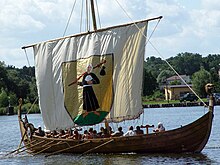维京长船:修订间差异
小 添加 {{notchinese}}标记至条目,通過Friendly▫ |
无编辑摘要 |
||
| 第1行: | 第1行: | ||
{{notchinese|time=2009-12-13T01:54:00+00:00}} |
|||
[[Image:Gokstadskipet1.jpg|thumb|The Gokstad ship,展览于[[挪威]][[奥斯陆维京船博物馆]].]] |
[[Image:Gokstadskipet1.jpg|thumb|The Gokstad ship,展览于[[挪威]][[奥斯陆维京船博物馆]].]] |
||
'''维京长船'''({{lang-da|Langskib}},{{lang-no|Langskip}},{{lang-is|Langskip}})是斯堪的纳维亚和冰岛的[[维京人]]在[[维京时期]]使用的贸易、商务、探险和福利用船。长船的设计经历了很多年,从石器时代开始 |
'''维京长船'''({{lang-da|Langskib}},{{lang-no|Langskip}},{{lang-is|Langskip}})是斯堪的纳维亚和冰岛的[[维京人]]在[[维京时期]]使用的贸易、商务、探险和福利用船。长船的设计经历了很多年,从石器时代umiak的发明开始一直到9世纪的Nydam and Kvalsund长船。长船在9至13是基本定型。这些船的特征和外表直到在今天在的斯堪的那维亚造船传统还有体现T。维京长船的速度因型号而异,但大多在5-10 [[节]],在理想情况下最高可达15节。<ref>http://www.vikingeskibsmuseet.dk/index.php?id=1404&L=1</ref> |
||
==分类== |
==分类== |
||
长船可以根据尺寸、建设情况和显赫程度分为很多种类。最简单的分类法是根据船上摇橹人的数量。 |
|||
Longships can be classified into a number of different types, depending on size, construction details, and prestige. The most common way to classify longships is by the number of rowing positions on board. |
|||
===Karvi=== |
===Karvi=== |
||
| 第12行: | 第11行: | ||
===Snekkje=== |
===Snekkje=== |
||
[[Image:Moragsoorm.jpg|thumb|全尺寸的维京Snekkje复制品,位于波兰[[Morąg]]]] |
[[Image:Moragsoorm.jpg|thumb|全尺寸的维京Snekkje复制品,位于波兰[[Morąg]]]] |
||
Snekkje的意思是细长而 |
Snekkje的意思是细长而突出,是在战时应用的最小的维京长船,至少有20名桨手。典型的snekkje至少长{{convert|17|m|ft}}, 宽{{convert|2.5|m|ft}},吃水仅仅{{convert|0.5|m|ft}}。这种船能承载41名船员(40 oarsmen and one cox). |
||
===Skei=== |
===Skei=== |
||
Skei意思是乘风破浪的东西,这是一种战船,包括超过30名摇橹人。 |
Skei意思是乘风破浪的东西,这是一种战船,包括超过30名摇橹人。这种船是以发现的最大的维京长船。 |
||
丹麦考古学家分别与1962和1996/7年在[[罗斯基勒]]港区发现了不少这种船。 其中一艘叫作''Skuldelev 2'',1962年出土,是橡木制的Skei长船。据推测这艘船与1042年建造于[[都柏林]]地区。''Skuldelev 2''能装70-80船员,长度上接近{{convert|30|m|ft}}。1996/7考古学家在海港附近发现了另一艘船的遗迹。这艘叫作''罗斯基勒6号Roskilde 6''还没有完全测量,细节上不清楚。但是据信这船大约{{convert|36|m|ft}}长,建于11世纪中叶。 |
|||
A group of these ships were discovered by Danish archaeologists in [[Roskilde]] during development in the harbor-area in 1962 and 1996/7. The ship discovered in 1962, ''Skuldelev 2'' is an oak-built Skei longship. It is believe to be built in the Dublin area around 1042. ''Skuldelev 2'' could carry a crew of some 70-80 and measures just fewer than {{convert|30|m|ft}} in length. In 1996/7 archaeologists discovered the remains of another ship in the harbor. This ship, called the ''Roskilde 6'', has not yet been fully investigated and full details are not available. It is however thought to be around {{convert|36|m|ft}} long, and has been dated to the mid-11th century |
|||
===Drekar=== |
===Drekar=== |
||
2009年12月13日 (日) 08:48的版本

维京长船(丹麥語:Langskib,挪威語:Langskip,冰島語:Langskip)是斯堪的纳维亚和冰岛的维京人在维京时期使用的贸易、商务、探险和福利用船。长船的设计经历了很多年,从石器时代umiak的发明开始一直到9世纪的Nydam and Kvalsund长船。长船在9至13是基本定型。这些船的特征和外表直到在今天在的斯堪的那维亚造船传统还有体现T。维京长船的速度因型号而异,但大多在5-10 节,在理想情况下最高可达15节。[1]
分类
长船可以根据尺寸、建设情况和显赫程度分为很多种类。最简单的分类法是根据船上摇橹人的数量。
Karvi
Karvi被认为是最小的长船
Snekkje

Snekkje的意思是细长而突出,是在战时应用的最小的维京长船,至少有20名桨手。典型的snekkje至少长17米(56英尺), 宽2.5米(8.2英尺),吃水仅仅0.5米(1.6英尺)。这种船能承载41名船员(40 oarsmen and one cox).
Skei
Skei意思是乘风破浪的东西,这是一种战船,包括超过30名摇橹人。这种船是以发现的最大的维京长船。 丹麦考古学家分别与1962和1996/7年在罗斯基勒港区发现了不少这种船。 其中一艘叫作Skuldelev 2,1962年出土,是橡木制的Skei长船。据推测这艘船与1042年建造于都柏林地区。Skuldelev 2能装70-80船员,长度上接近30米(98英尺)。1996/7考古学家在海港附近发现了另一艘船的遗迹。这艘叫作罗斯基勒6号Roskilde 6还没有完全测量,细节上不清楚。但是据信这船大约36米(118英尺)长,建于11世纪中叶。
Drekar
参见Drekar
Busse
Busse是大型长船,能比Skei承载更多的人和货物。Ormen Lange就是典型的Busse长船。
建造

航海

维京人是判断风力和风向的专家,也善于感知水流及潮水涨落。维京导航技术并不为现代人所了解,但是历史学家postulate that the Vikings probably had some sort of primitive astrolabe and used the stars to plot their course.
丹麦考古学家Thorkild Ramskou在1967年说"sun-stones" referred to in some sagas might have been natural crystals capable of polarizing skylight. The mineral cordierite occurring in Norway has the local name "Viking's Compass." Its changes in colour would allow determining the sun's position (azimuth) even through an overcast or foggy horizon. See here.
传奇

参见
外部链接
- 罗斯基勒的维京船博物馆
- 奥斯陆的维京船博物馆
- The Ormen Friske disaster – a warning against construction errors in Viking ship replicas
- The Ormen Friske disaster in 1950 investigated
- Viking ships and traditional Norse wooden boats
参考
- W. Fitzhugh and E. Ward, Vikings: The North Atlantic Saga. Washington: Smithsonian Institution Press. 2000.
- A. W. Brøgger, The Viking ships, their ancestry and evolution. Oslo, Dreyer. 1951.
- K. McCone, 'Zisalpinisch-gallisch uenia und lokan' in Festschrift Untermann, ed Heidermans et al., Innsbruck, 1993.1.
- L. Trent, The Viking Longship. 1st ed. San Diego: Lucent Books, 1999.
- A. Forte, R. Oram, and F. Pederson. Viking Empires. 1st. ed. Cambridge: Cambridge University Press, 2005 ISBN 0-521-82992-5.
- D. Dersin, ed., What Life Was Like When Longships Sailed. 1st ed. Richmond: Time Life Books, 1998.
- A. W. Brøgger and H. Shetelig, The Viking Ships. Twayne Publishers, New York, 1971, and C. Hurst, London, 1971.
- J. R. Hale, 'The Viking Longship'. Scientific American February 1998: 58-66.
- Chartrand, Rene, Mark Harrison, Ian Heath, and Keith Durham. The Vikings: voyagers of discovery and plunder. Osprey Publishing, 2006. 142-190.
- Durham, Keith. Viking Longship. Osprey Publishing, 2002. 5-45.
